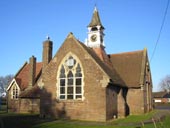A small village on Cornwall’s northern coast, St Agnes has a population of around 2,000 and a history stretching back to Roman times and beyond. Traditionally relying on fishing and agriculture for its economic survival, it was also heavily reliant on the mining of tin up to the beginning of the twentieth century. Modern day St Agnes is a renowned Cornwall holiday destination, popular for cottage style holidays, and a great area for hiking and walking, with miles of beautiful coastline surrounding the village. Places of interest in and around St Agnes include St Agnes Beacon (623 foot high landmark owned by the National Trust), St Agnes Parish Museum, Bolster and Chapel Porth (earthen bulwark), and the Wheal Coates ancient mining buildings. Other places worth a visit are Porthtowan which has an excellent beach popular with surfers, Mounte Hawke with its fabulous skateboard park, Newquay, the biggest resort in the region and again renowned for its surfing beaches, and Redruth, a historic market town to the south of St Agnes. St Agnes can be reached via the B3277. St Agnes Map.
February 18, 2010
January 22, 2010
Barnsole Vineyard Canterbury Kent
If you are visiting Canterbury in Kent, United Kingdom this year, and are looking for something a little different to do, why not try a visit to the Barnsole Vineyard, a family run vineyard which produces high quality wines and welcomes visitors for free wine tastings and a guided tour of the vineyard which covers an area of just 3 acres. Open from April to October when the Canterbury weather is at its best, a charge of just £1.50 per person is asked for a guided tour of the vineyard, you can also purchase wine on the premises. The Barnsole Vineyard is located on Fleming Road, Staple, Canterbury and the telephone number is 01304 812 530. Why not take out an hour or two to visit this interesting and different Kent attraction. Canterbury Map.
January 15, 2010
Aston Clinton Buckinghamshire

Aston Clinton Parish Church
A small village located to the east of Aylesbury in the county of Buckinghamshire, England, United Kingdom, Aston Clinton has a population of 3,000 and has been a settlement since at least Saxon times and possibly earlier (a Roman cemetery has been found nearby). It was important enough to be mentioned in the Domesday Book, where it was names as Estone. The construction of it’s parish church begun during the twelfth century and later work was done subsequently with a full restoration in 1867. It became the home of Sir Anthony de Rothschild during the 19th century and it was Sir Anthony who gave the Aston Hall to the village for use as a school. Aston Clinton is notable as having given it’s name to the Aston Martin car after one of the founders of the company entered a hill climbing trial on Aston Hill. Modern day Aston Clinton is a charming little village and a desirable location to live with easy access to the busy town of Aylesbury.
November 20, 2009
Watford Hertfordshire
First mentioned in Anglo Saxon chronicles of 1007, the town of Watford, in Hertfordshire, United Kingdom, was never listed in the Domesday Book, and remained a small rural community ruled by a succession of feudal lords for many centuries, becoming a market town during the 18th century. The Industrial Revolution of the late 18th and 19th centuries brought industry to the town, accelerated by the arrival of both the Grand Union Canal and the railway. As the factories and mills fell into ruin and disappeared, Watford became an important commercial centre for the Home Counties. Watford these days has a population of just under 80,000 and is well known for its football club Watford FC, and its chairman musician Elton John who grew up in the area. Watford Map.
November 18, 2009
Bradford West Yorkshire
A large city located in West Yorkshire, England, United Kingdom, Bradford has a population of around half a million, making it one of the biggest metropolitan boroughs in the country. Situated in the foothills of the Pennines, Bradford was listed as “Bradeford” in the Domesday Book (1086), originally settled during Saxon times, Bradford later grew in prosperity around the wool trade, this increased rapidly during the Industrial Revolution, when it became known as “the wool capital of the world”. Bradford became a municipal borough in the mid-nineteenth century and gained city status in 1897. The wool industry declined during the 20th century and the city experienced considerable immigration during the second half of the century making it a diverse and vibrant community. Worth visiting in Bradford are the National Media Museum, Saltaire (an example of a Victorian village and a World Heritage Site) and Cartwright Hall.
See a map of Bradford here: http://www.my-towns.co.uk/bradford-map.html
And the latest weather in Bradford here: http://www.my-towns.co.uk/bradford-weather.html
November 9, 2009
Hertfordshire Towns – Harpenden
A small town in the county of Hertfordshire, UK, Harpenden is within the district of St Albans and has an interesting history. Roman remains discovered in areas around Harpenden suggest of settlements in the centuries BC, however the original village of Harpenden developed as woodland was cleared under Edward the Confessor during the eleventh century, to make room for farming around Wheathampstead Manor, the first church to be built was the St Nicholas church (1217). Somewhat later during the Wars of the Roses, a common close to Harpenden was the site of the Second Battle of St Albans. During the early 19th century, Harpenden was the location of the 1st annually run steeplechase race, and was a popular location for horse racing throughout the century. The face of Harpenden changed forever with the arrival of the railway, as farms were replaced with residential development. During WW2 the town was used for the evacuation of children from bomb torn London. Harpenden today is mostly a commuter town, which enjoys excellent road and rail links with London.